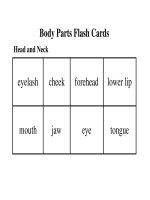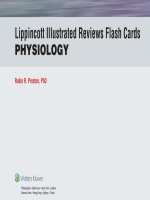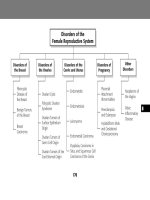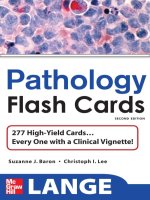Ebook Pathophysiology flash cards: Part 2
Bạn đang xem bản rút gọn của tài liệu. Xem và tải ngay bản đầy đủ của tài liệu tại đây (3.61 MB, 258 trang )
A 46-year-old male presents to his primary care physician with a complaint of
troublesleeping. He states that he lies in bed for up to 3 hours before falling
asleep but does not have problems staying asleep. Further questioning reveals
thatthepatientlosthisjob5monthsagoandhisfamilyhasbeenrelyingonhis
wife’spart-timeincome.Hestatesthathehasbeenfeelingdepressedforthepast
severalmonths,ashehasnotbeenabletofindanothersourceofemploymentto
support his family. He feels it is hopeless to continue to find a job, and now
spends mostofhistimenow on the couch watching TV. He has no interest in
activities he used to enjoy. He reports a decreased appetite but denies weight
loss, problems concentrating, substance abuse, or suicidal ideations. His only
past medical history includes stage I hypertension well controlled with
hydrochlorothiazide.Physicalexaminationrevealsanappropriatelydressedmale
witharestrictedaffectandlinearthoughtprocess.
MajorDepressiveDisorder
This patient has major depressive disorder. Although there are often several
criteria for many diagnoses in psychiatry, it is important to first commit to
memorythetimerequirementsandnumberofsymptoms.Formajordepressive
disorder,fivesymptomsmustbepresent,oneofwhichmustbeeitherdepressed
moodoranhedonia(lackofInterest),foraminimumof2weeks.Therestofthe
nine possible symptoms are Sleep disturbance, feelings of worthlessness or
inappropriate Guilt, lack of Energy, diminished Concentration, change in
Appetiteorweight,Psychomotoragitationorretardation,andSuicidalideations.
AusefulmnemonicisSIGECAPS.Thevignettedoesnotdescribeanyhistory
ofmanicepisodesthatcouldindicatebipolardisorder.Ifthepatienthadnotmet
atleast fivecriteria, adiagnosisofadjustment disorder could be considered as
hissymptomswereprecipitatedbyamajorlifestressorthatwasinitiatedwithin
3 months of the stressor and had not persisted for more than 6 months. In
dysthymicdisorder,apatientexhibitsalesssevereformofdepressiononmore
thanhalfofthedaysforaperiodofmorethan2years.
A27-year-oldfemalemedicalstudentisbroughttotheemergencydepartmentby
herroommatewhoisconcernedaboutherlackofsleeping.Thepatienthasnot
sleptin2daysandhasbeenfranticallycleaningtheirapartment.Theroommate
alsostatesthatthepatienthasbeenactingunusuallypromiscuousoverthepast
week and accumulated thousands of dollars in credit card charges buying new
clothes.Thepatientstatesshefeelsgreatandjusthasnotbeenfeelingtired.Her
past history issignificantfor one suicide attempt at 17 years after breaking up
witha boyfriend.Shewassubsequentlytreated with fluoxetine for 2 years but
currentlytakesnomedications.Onexamination,thepatientishyperverbalwith
psychomotor agitation and reports that she is on the verge of discovering the
cureforcancer.
BipolarDisorder
This patient has bipolar I disorder. This diagnosis requires the presence of at
least one manic episode, usually with a history indicative of one or more
episodes of major depressive disorder. A manic episode consists of at least 1
week of an abnormally elevated, expansive, or irritable mood or a required
hospitalization with at least three symptoms. Symptoms include distractibility,
insomniaordecreasedneedforsleep,grandiosity(inflatedself-esteem),flightof
ideas (racing thoughts), psychomotor agitation or increase in goal-directed
activities, pressured speech, and risk-taking (activities involving pleasure with
painfulconsequences,i.e.,excessivespending,sexualindiscretion,gambling).A
useful mnemonic is DIG FAST. For bipolar I disorder, the mood disturbance
must be sufficient enough tocausesocialor occupational impairment, requires
hospitalization,orhaspsychoticfeatures.Ifthisisnotthecase,butatleastthree
symptoms with mood change have been present for at least 4 days, it is
consideredahypomanicepisodeandthediagnosiswouldbebipolarIIdisorder.
It is important to distinguish the symptoms from personality disorders, as the
personalitydisordersarereportedunderaxisIIdiagnoses.
An 11-year-old boy is brought to the pediatrician by his mother, who is
concernedabouthisbehavior.Shestateshehasbecomeincreasinglyrebellious
since his parentsdivorced 3 years ago. He was recently suspended for making
funofasmallerclassmateandhismotheroftenreceivescallsfromtheteacher
fortalkingback.Herefusestodohishomeworkandisverballyabusivetohis
mother. Physical examination reveals a slightly overweight boy, appropriately
dressed with normal affect, and linear thought process without psychomotor
agitation.
OppositionalDefiantDisorder
This patient is presenting with oppositional defiant disorder. This is
characterizedbyongoingdefiantandhostilebehaviortowardauthorityfigures.
This differs from conduct disorder in that there are not serious violations of
socialnorms,suchasphysicalaltercations,propertydestruction,animalcruelty,
theft, or other activities that might rise to the level of concern to law
enforcement. Conduct disorder also often progresses to antisocial personality
disorderafter18yearsofage.Otherconsiderationsmightbeseparationanxiety
disorder following the loss of an attachment figure in the divorce, which
typicallystartsataround7to8yearsofage.
A 36-year-old male is presented at the emergency department by the police
because he was found standing on the side of the highway. The patient claims
thathefeltlikehewasunabletomoveandhedoesnotrememberhowlonghe
wasstandingthere.HethinksthatFBIagentshavebeenfollowinghimforthe
past 6 months, and he does not feel safe at home anymore. He also admits to
having intermittent thoughts of committing suicide. During the interview, he
mentionsthathisthoughtsofsuicideareaugmentedduetothevoicestellinghim
to “end it.” The patient’s past medical history is significant only for wellcontrolled type 2 DM. His vital signs on admission are heart rate is 78/min,
respiratory rate is 16/min, blood pressure is 118/82 mm Hg, temperature is
36.7°C (98.1°F), and oxygen saturation is 99%. On further examination, the
patientdisplays flataffect,paranoia,tangentialandillogicalthoughtprocesses,
anddisorganizedspeech.Urinedrugscreeningisnegativeforillicitsubstances.
Schizophrenia
This patientmeets the DSM-IV criteria for schizophrenia, which requires more
than6monthsofdisturbedfunctioningwithatleast1monthofatleasttwoof
thefollowingsymptoms(unlessdelusionsarebizarreorvoicesproviderunning
commentary, then only one criterion is needed): delusions, hallucinations,
disorganized behavior/catatonia, disorganized speech, and negative symptoms.
These symptoms arise from a decrease in dopaminergic activity. Negative
symptoms (anhedonia, flat affect, avolition) stem from the frontal cortical
region,whereaspositivesymptoms(delusionsandhallucinations)arisefromthe
mesolimbic system. Typical treatment consists of dopamine antagonists.
However, due to high incidence of tardive dyskinesia and extrapyramidal
symptoms associated with D2 dopamine receptor blockade in typical
antipsychotics,atypicalantipsychoticsareusuallythefirst-linepharmacotherapy.
A23-year-oldmaleisbroughttoapsychiatristbyhismother.Shereportshehas
been behaving strangely since he graduated from college 3 months ago. He
stoppedsocializingwithhisfriendsandnowspendstheentiredayinhisroom.
Upon questioning, he is reluctant to answer simple questions. He eventually
reveals that God has been speaking to him and providing him instructions for
creating a device, which will allow him to read other people’s thoughts.
Examination reveals an unkempt, disheveled male with restricted affect and
circumstantialthoughtprocess.Urinedrugscreeningwasnegative.
SchizophreniformDisorder
This patient has schizophreniform disorder. The length of time of continuous
signs of disturbance differentiates the disorders presenting with symptoms of
schizophrenia.Briefpsychoticdisorderdenoteslessthan1monthofsymptoms,
usually related to stress. More than 1 but less than 6 months of disturbed
behaviorincludingoccupational/socialdeclinesornegativesymptomsincluding
1 month of psychotic symptoms is classified as schizophreniform disorder.
Symptoms persisting for more than 6 months indicate schizophrenia.
Schizophreniacriteriaplusmajordepression,manicepisodes,orbothindicatesa
diagnosis of schizoaffective disorder. It is important to distinguish axis I
disordersfromtheschizoidandschizotypalpersonalitydisordersthatarepartof
axisII.
A34-year-oldwomanisbeingseenintheemergencydepartmentforchestpain
that started 2 hours ago. She states it came on quickly and lasted less than 20
minutes.Theeventwasaccompaniedbypalpitations,sweating,andshortnessof
breath.Shecurrentlyhasnopainorothersymptoms.Earlierintheeveningshe
hadanargumentwithherboyfriend.Shehashadonesimilarepisodeinthepast,
butitresolvedin10minutesandshedidnotseekmedicalattention.Shetakesa
PPI for mild GERD. Her blood pressure is 128/78 mm Hg, pulse is 84/min,
respiratoryrateis14/min,andtemperatureis37.5°C(99.5°F).Shehasanormal
S1andS2 without additional heart sounds, murmurs, or rubs. Chest is clear to
auscultation bilaterally. ECG shows a normal sinus rhythm. Chest X-ray is
normalandaurinedrugscreeningisnegative.
PanicAttack
Thispatienthashadapanicattack.Panicattackscanpresentwithavarietyof
symptomsincludingpalpitations,sweating,trembling,sensationofshortnessof
breath or smothering, feeling of choking, chest pain or discomfort, nausea or
abdominaldistress,derealizationordepersonalization,fearoflosingcontrol,fear
ofdying,paresthesias,andchillsorhotflushes.Theattackmustbeaperiodof
intensefearordiscomfortwithfourormoresymptomsdevelopingabruptlyand
reaching a peak within 10 minutes. This should be considered in a young,
healthypatientwithchestpainandotherwisenormalfindings,particularlywhen
accompaniedbyaprecipitatingevent.Inthiscase,thepatient’sattackmayhave
been triggered by the argument. Panic disorder is characterized by recurrent
unexpected panic attacks or persistent concern of having a panic attack or its
consequences.Thismayormaynotbeaccompaniedbyagoraphobia,afearof
being in public places. Panic attacks on exposure to specific situations are
characterized as a specific phobia. It is important to rule out cocaine-induced
myocardialischemia,whichcanbeseenonECGandurinedrugpanel.
A42-year-oldwomanisbeingseenbyherprimarycarephysicianforanannual
visit. Her only complaint is daytime fatigue that has been affecting her
performance at work. She denies any fever, weight changes, temperature
intolerance, weakness, or lightheadedness. Inquiry into sleep patterns reveals
thatsheawakensinfeareachnightduetorecurringdreamsofbeingfollowed,
often with palpitations and profuse sweating. After further questioning, she
tearfully admits that she was sexually assaulted in a parking garage 3 months
ago. Further discussion reveals that the patient has debilitating panic attacks
whenever she sees a parking garage and now avoids going out in public
wheneverpossible.
PosttraumaticStressDisorder
Thispatienthasposttraumaticstressdisorder(PTSD).PTSDischaracterizedby
the exposure to a traumatic event that the person persistently re-experiences.
This may be through intrusive thoughts of recollection, recurrent dreams,
flashbacks, or intense responses to external cues. Patients will also have
increasedarousalandavoidanceofstimuliassociatedwiththeevent.Thelevel
ofdisturbanceinPTSDwillcauseimpairmentofsocial,occupational,orother
importantareaoffunctioning.Inaddition,likeanyotherdiagnosisinpsychiatry,
the condition must not be due to the effect of a substance (e.g., illicit drug,
medication), medical condition, or exacerbation of a preexisting axis I
(psychiatric)oraxisII(personality)disorder.PTSDcanpresentwithsymptoms
similar to generalized anxiety disorder, so a complete history is essential. It is
important to note that in patients with PTSD who have a military background,
there is a high incidence of concurrent substance abuse. Therefore, it is
important to screen for alcohol and drug use, and generally, BZDs are not
recommendedinthispopulation.
A 16-year-old female is brought to the gynecologist by her mother for
amenorrhea.Herfirstmenseswasat12yearsofage,andshedevelopedregular
monthlycyclesuntilaboutayearago.Herlastmenseswas6monthsago.The
patient states that she is not sexually active. Physical examination reveals a
slenderfemale,TannerStageV.Sheis65inches(165cm)tallandweighs104lb
(47.2kg)withaBMIof17.1kg/m2.Pelvicexaminationisunremarkable.Skin
examinationshowssoft,finehaironherextremitiesandasmallabrasionofthe
skin over the right third and fourth metacarpophalangeal joints. When asked
abouttheabrasion,thepatientstatesshescratchedherhandduringgymnastics
practice.
AnorexiaNervosa
Thispatienthasanorexianervosa.TomeettheDSM-IVcriteria,apatientmust
be less than 85% of ideal body weight, but maintain a distorted impression of
theirbodyweightorshape,withanintensefearofgainingweightand3months
of amenorrhea. Since calculating 85% of total body weight can be time
consumingintheclinicalsetting,aBMIoflessthan17.5kg/m2istypicallyused
as the standard indicating an anorexic weight range. Amenorrhea in anorexia
nervosaisaresultoflowlevelsofluteinizinghormone(LH)andsuppressionof
physiologic hormone fluctuations. Lanugo (thin body hair) is one of many
complications that can develop from anorexia, which can also include
osteoporosis, cachexia, cardiac arrhythmias, and even sudden death. This
patient’s skin abrasion is suggestive of self-induced vomiting. Anorexics may
achieveand maintaintheir lowweightthroughanumberofmethodsincluding
binging, purging (vomiting, laxative abuse, diuretics, etc.), excessive exercise,
and starvation. Complications of purging can include electrolyte abnormalities
(particularly hypokalemia), salivary gland enlargement, dental caries, and
seizures.Patientswithbulimianervosaalsobingeandpurge;however,theyhave
anormalorhighBMI,withoutsuchdistortioninbodyperception.Patientsmay
alsohaveanisolateddistortedperceptionofaspecificpartoftheirbody,which
isknownasbodydysmorphicdisorder.
A57-year-oldmalepresentstohisprimarycarephysicianforfollow-uponhis
hypertension.In addition, he notes that he is always tired and frequently falls
asleep at work. He reports that he usually goes to bed around 10:30 PM and
wakesupat7:00AManddoesnothaveproblemsfallingasleeporstayingasleep.
However, he is still very tired when his alarm clock wakes him up. He takes
lisinoprilandhydrochlorothiazideforhypertension.Hisbloodpressureis158/86
mm Hg, pulse is 74/min, respiratory rate is 14/min, and temperature is 36.9°C
(98.4°F).Thepatient’sBMIis35kg/m2.Physicalexaminationshowsanobese
malewithamildlyerythematousoropharynx,andpresenceofanS4heartsound
inadditiontoS1andS2.
ObstructiveSleepApnea
This patient has obstructive sleep apnea (OSA), which is characterized by
functional obstruction of the upper airway for brief periods while the patient
sleeps.Thesepauses(periodsofapnea)lastatleast10secondsandoftenlonger,
leading to a decrease in arterial oxygen saturation and transient arousal from
sleep. Patients are usually not aware of these disturbances while they are
sleeping,butwilloftenawakefromasufficientperiodofsleepwithoutfeeling
refreshed and have unexplained excessive daytime sleepiness. Typically, a
partner will also note that they snore loudly. OSA is generally found in
individuals with obesity and is frequently associated with hypertension.
Narcolepsy is much less common, but also presents with excessive daytime
sleepiness and intrusion of aspects of rapid eye movement (REM) sleep into
daytimewakefulness.Themostcommonsymptomsaresleepattacks,inwhicha
patient cannot avoid falling asleep, typically leading to irresistible 10- to 20minute periods of sleep. These can occur at very inconvenient times, such as
whiledriving,andmayincludecataplexy,asuddenlossofmuscletone,thatmay
leadtocollapsefromparalysisofallskeletalmuscles.Otherconditionsthatcan
leadtodaytimesleepinessincludeshiftwork(disruptionofcircadianrhythms),
restlesslegsyndrome,jetlag,andinsufficientsleep.
A33-year-oldfemalepresentstotheemergencydepartmentwithacuteepigastric
pain. She describes the pain as sharp, constant, and unbearable. It is not
associatedwitheating and gets worse with moving. Review of systems is also
positive for headache, nausea, dizziness, dyspha-gia, shortness of breath, neck
pain, easybruising, and increased urinary frequency. She is afebrile, and other
vitalsignsarenormal.Examinationrevealsasoft,nondistendedabdomen with
normo-active bowel sounds that is tender to percussion and palpation in all
areas. There is no guarding or rebound tenderness. A review of her records
showsthatshewasrecentlyadmittedandreceivedacolonoscopyforintractable
diarrhea. She has also had several visits over the past few years for
gastroenteritis,unexplainedkneepain,andaurinarytractinfection.Inaddition,
she underwent exploratory laparoscopy for menometrorrhagia and underwent
diagnosticevaluationforpossiblemultiplesclerosis.
SomatizationDisorder
Thispatienthassomatizationdisorder,averyspecificdiagnosisoutofthefive
somatoform disorders. It entails a history of multiple physical complaints
beginningbeforetheageof30yearsandoccurringoveraperiodofyearswith
eithertreatmentorsignificantimpairmentinsocialoroccupationalfunctioning.
The complaints must include four pain symptoms (related to at least four
different sites or functions), two GI symptoms other than pain (e.g., nausea,
vomiting, diarrhea), one sexual or reproductive symptom other than pain (e.g.,
sexual dysfunction, irregular menses), and one pseudoneurological symptom
other thanpain (e.g.,impaired coordination,weakness, doublevision),none of
whichcanbeexplainedbyphysicalorlaboratoryexamination.Inthisdisorder,
the symptoms are the result of unconscious psychological factors and are not
intentionally produced, such as in factitious disorder, where the patient
motivation is to assume the sick role, or in malingering, where external
incentives such as financial gain are present. Related disorders include pain
disorder,inwhichpainatoneormoreanatomicalsitesisthepredominantfocus,
and conversion disorder, manifested by one or more neurologic symptoms
affectingvoluntarymotororsensoryfunction.
A 16-year-old girl presents with concerns about daily headaches and blurred
vision. She also complains of weight gain and constipation over the past 3
months. She is fatigued, has a low exercise tolerance, and is feeling stressed
keeping upwithschoolwork. She has missed her last four periods. She is not
sexuallyactive.Menarcheoccurredattheageof12years.Herbloodpressureis
85/55 mm Hg, pulse is 66/min, respiratory rate is 14/min, and temperature is
36.8°C(98.1°F).Sheis157cm(5ft2in)tallandweighs65kg(143lb);BMIis
26kg/m2.Physicalexaminationrevealsapalegirlwithcoolextremities.There
are scattered dry patches of skin on her torso. Her reflexes are hypoactive
bilaterally,andhertemporalvisualfieldsaredecreased.Initiallaboratoryresults
arenotableforhyponatremia,hypercholesterolemia,andlowTSH.Apregnancy
testisnegative.Sheisreferredforfurtherendocrinetestingandcranialimaging.
AnteriorHypopituitarism
This patient has anterior hypopituitarism. There is decreased secretion of more
thanoneoftheanteriorpituitarytropins.Theconditionmaybecausedbylesions
to the hypothalamus,pituitarystalk,orpituitarygland.Hypopituitarismcan be
causedbymasslesionsincludingpituitarytumors,braintumors,granulomas,or
cysts, or may occur without mass lesions in cases such as trauma, ischemia,
radiation treatment, or congenital syndromes. The presence of headache and
visual field defects in this patient suggests a mass lesion pressing on the optic
chiasm, which is located immediately above the pituitary gland. Weight gain,
constipation,fatigue,skinlesions,hypercholesterolemia,andhypoactivereflexes
are most likely related to secondary hypothyroidism (low TSH). Secondary
amenorrhea is due to decreased follicle-stimulating hormone (FSH) and LH
secretion. Hypotension, hyponatremia, and a difficulty coping with stress
suggest ACTH deficiency as do decreased cortisol and epinephrine levels.
Furthertestingwouldrevealwhichofthetropinsareinvolved.MRIwouldmost
likely reveal a mass lesion in this case. Ultimately, this condition is managed
withtranssphenoidalremovalofthetumor,followedbyreplacementtherapyfor
affected pituitary hormones. The patient does not have posterior pituitary
involvementnowbutwilllikelyalsoneedvasopressinreplacementaftersurgery.
A 58-year-old male presents at the emergency room following a motor vehicle
accident.Hehasminorinjuriesfromtheaccidentbutreportsfrequentheadaches
andblurred vision that have worsened over the past several weeks. This is his
secondmotorvehicleaccidentinthepast3months.Bloodpressureis170/110
mm Hg, pulse is 78/min, respiratory rate is 16/min, and temperature is 37.0°C
(98.6°F).Physicalexaminationisnotableforcoarsefacialfeatures,largedoughy
hands,andlarge,widefeet.Laboratorydataobtained3dayslaterarenotablefor
hyperglycemiaandincreasedinsulin-likegrowthfactor-1(IGF-1)concentration;
serumlevelsofprolactin,TSH,serumelectrolytes,liverenzymes,andBUNare
allwithinreferencerange.Cranialimagingindicatesapituitarymass.
Acromegaly
This patient has acromegaly due to excess growth hormone (GH) secretion. In
almost all cases, excess GH secretion from a pituitary adenoma is the cause.
Commonly, there is concomitant secretion of prolactin, and disruption of TSH
secretion, although these confounding problems are not present in this patient.
Headache and temporal hemianopia result from the pituitary mass pressing on
the optic chiasm. GH promotes somatic growth mainly through its action to
stimulatesecretionofIGF-1fromtheliverandothertissues.Inyoungpatients,
prior to closure of the epiphyseal growth plates, the result is gigantism. In
mature individuals there is growth of the skull, facial features, hands,andfeet
leading to the characteristic appearance of acromegaly. Growth of theinternal
organsalsooccursandcardiomegalyisofparticularconcern.Hypertensionisa
commonfindinginacromegalybutisofuncertainorigin.SinceGHisnormally
an anti-insulin hormone that helps to maintain blood glucose concentration in
responsetostressors,patientswithGHexcessfrequentlyhaveinsulinresistance
andmaydevelopDM,asinthiscase.Thetreatmentofchoiceistranssphenoidal
microsurgerytoremovethepituitaryadenomaandiscurativeinapproximately
70%ofcases.









